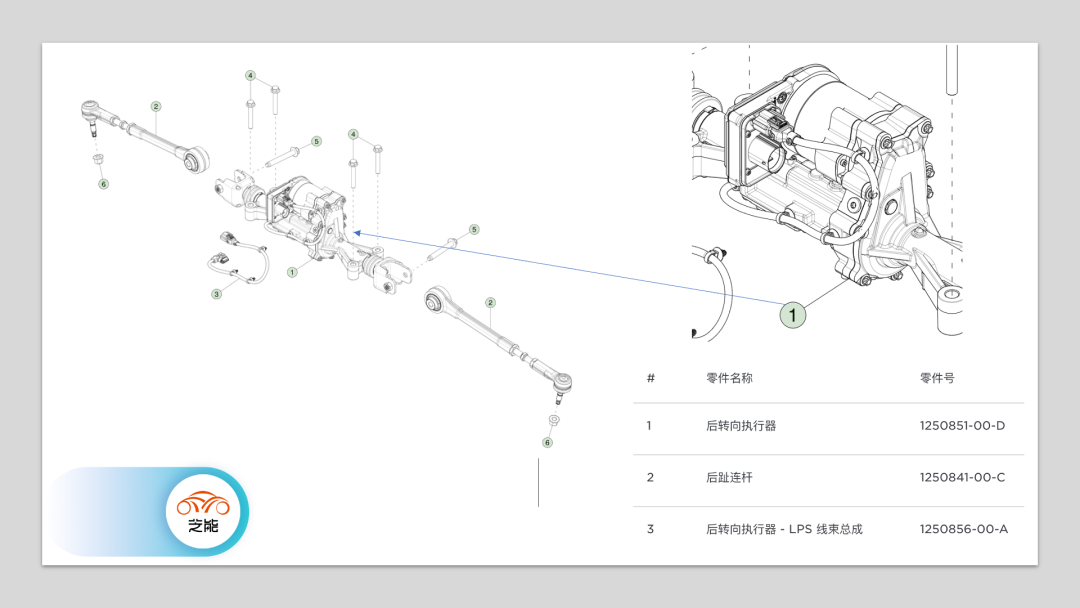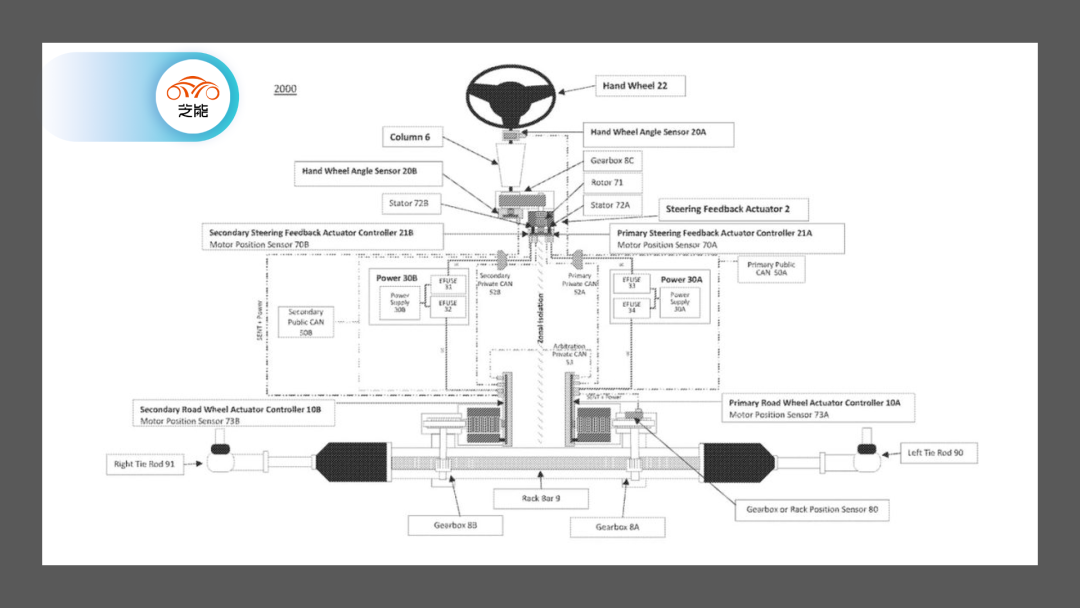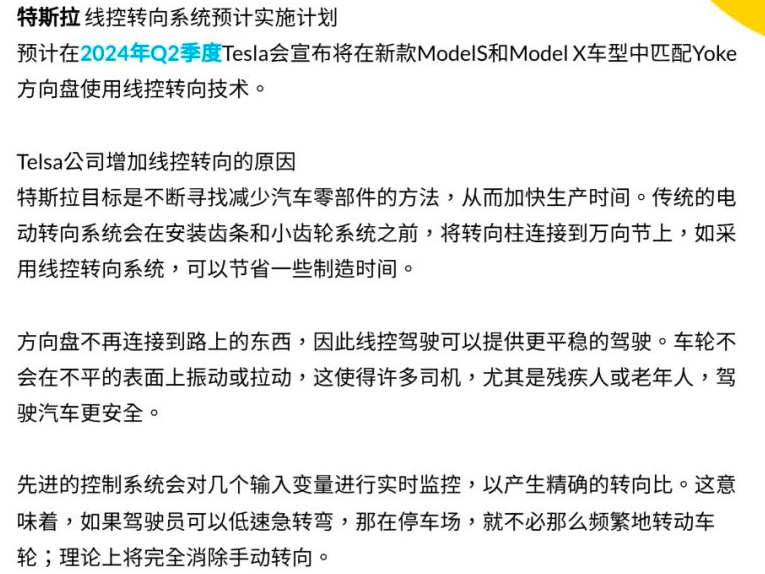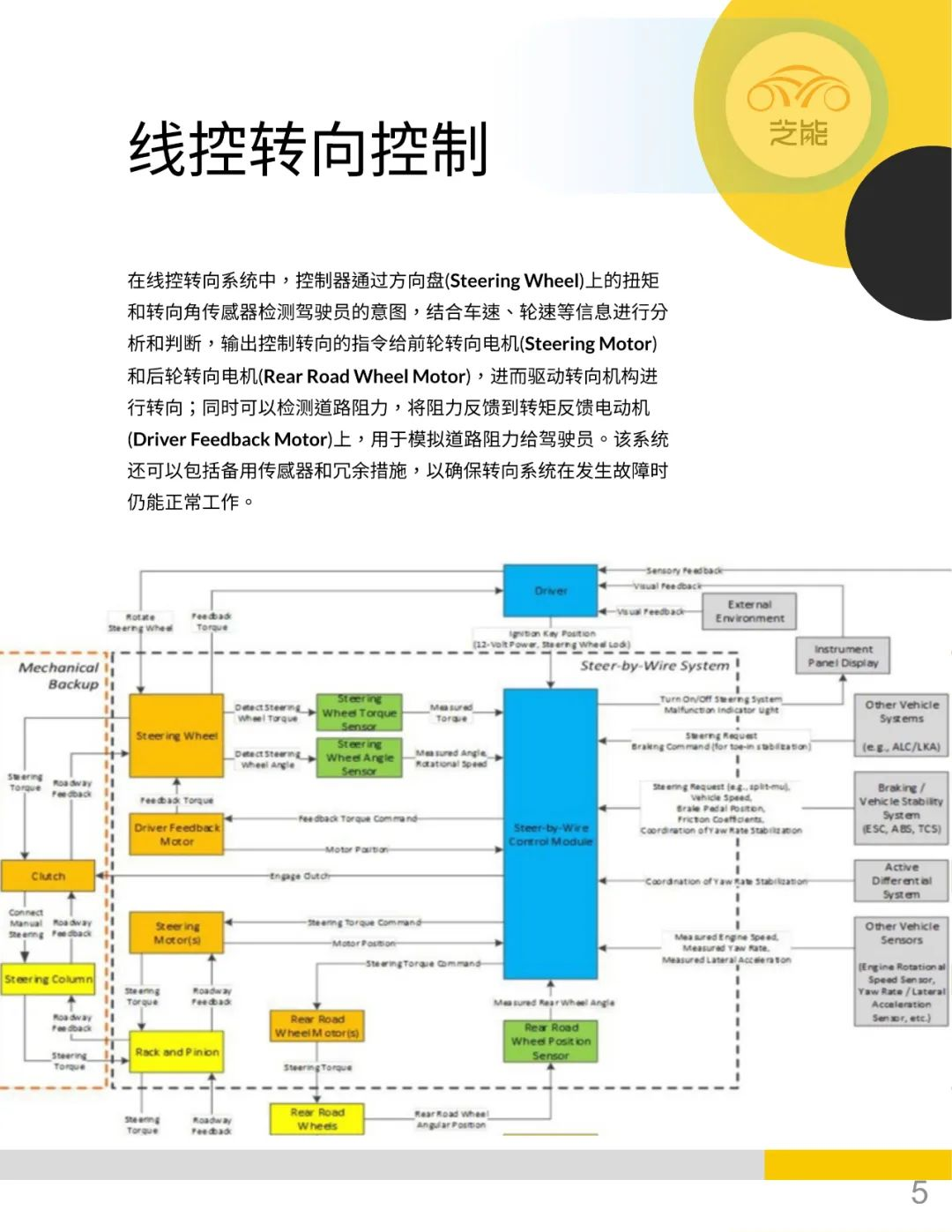The steer-by-wire system is an automotive electronic technology related to safety. By eliminating the hard connection between the front wheel and the steering wheel, an electrical signal is generated when the steering wheel is turned. The signal is transmitted to the steering drive motor, and the motor drives the steering mechanism to steer. The steer-by-wire system provides a variable steering ratio, allowing the driver to achieve a larger steering ratio by switching between different driving modes. It helps to reduce costs and improve production efficiency. Compared with the traditional electric power steering system, the steer-by-wire system reduces the number and complexity of parts and simplifies the entire structure, thereby saving manufacturing time and cost, which has significant advantages for mass production. The steer-by-wire technology can provide a smoother driving experience by eliminating the hard connection between the wheel and the steering wheel. On uneven roads, the system can reduce the vibration and pulling of the wheel, making driving safer and more comfortable. The steer-by-wire system improves the vehicle's handling flexibility, especially in narrow spaces. Through the precise control of the steering wheel by the electronic control unit, the system can adapt to different driving environments and driving styles and provide stable maneuverability.
We organize this system based on different information sources.
Part 1
Tesla's steer-by-wire system
1) Front steering system

2) Rear steering system

Physical picture
Based on the description in the patent, we can see that it is basically consistent with the finished product of this system.
Tesla's steer-by-wire system includes a steering wheel torque feedback actuator assembly, a front wheel steering actuator assembly, a power supply assembly, a vehicle communication network, and a dedicated communication system to improve system reliability through regional isolation of redundant components. The system may also include a differential gearbox road wheel actuator to allow absolute position of the road wheel, and a position sensor assembly, which includes a magnetic sensor and an inductive sensor.
This means there are four controllers here, two Primary/Secondary Steering Feedback Acuator controllers 21A and 21B for the steering wheels, and Primary/Secondary Road Wheel Acuator controllers at the execution level.

For CyberTruck, the use of wire-controlled steering and rear-wheel steering technology makes the vehicle more flexible and stable at low and high speeds. At low speeds, the rear wheels can rotate up to 10 degrees in the opposite direction, improving the vehicle's maneuverability in narrow spaces, especially making it easier to turn in parking lots. At high speeds, fine-tuning of the rear wheels provides more stable movement, making the vehicle change between lanes more smoothly and the overall driving feel more comfortable.
At present, Tesla will officially deliver the first batch of mass-produced models in Q1 2024.

Part 2
Design Challenges
This has been explained in the previous article "The Zhineng Report: Development Trends in Automotive Wire-Controlled Steering Technology".

Steer-by-wire technology also faces some challenges. Its highly integrated electronic technology and advanced sensor technology increase the difficulty of R&D and production, resulting in relatively high production costs. The system is highly dependent on power and electronic components. Once a failure occurs, the steering system may fail. At the Shanghai Auto Show, I took the time to visit Nexteer's booth to see the development of domestic steer-by-wire technology. Overall, Tier 1 suppliers focus on R&D reserves. Domestic automakers need Tesla to take the lead in this regard.
Previous article:Sensors and timing closed-loop applications in autonomous driving systems
Next article:Engine Basics: Automobile Engine Explosion Diagram
- Huawei's Strategic Department Director Gai Gang: The cumulative installed base of open source Euler operating system exceeds 10 million sets
- Analysis of the application of several common contact parts in high-voltage connectors of new energy vehicles
- Wiring harness durability test and contact voltage drop test method
- Sn-doped CuO nanostructure-based ethanol gas sensor for real-time drunk driving detection in vehicles
- Design considerations for automotive battery wiring harness
- Do you know all the various motors commonly used in automotive electronics?
- What are the functions of the Internet of Vehicles? What are the uses and benefits of the Internet of Vehicles?
- Power Inverter - A critical safety system for electric vehicles
- Analysis of the information security mechanism of AUTOSAR, the automotive embedded software framework
 Professor at Beihang University, dedicated to promoting microcontrollers and embedded systems for over 20 years.
Professor at Beihang University, dedicated to promoting microcontrollers and embedded systems for over 20 years.
- Innolux's intelligent steer-by-wire solution makes cars smarter and safer
- 8051 MCU - Parity Check
- How to efficiently balance the sensitivity of tactile sensing interfaces
- What should I do if the servo motor shakes? What causes the servo motor to shake quickly?
- 【Brushless Motor】Analysis of three-phase BLDC motor and sharing of two popular development boards
- Midea Industrial Technology's subsidiaries Clou Electronics and Hekang New Energy jointly appeared at the Munich Battery Energy Storage Exhibition and Solar Energy Exhibition
- Guoxin Sichen | Application of ferroelectric memory PB85RS2MC in power battery management, with a capacity of 2M
- Analysis of common faults of frequency converter
- In a head-on competition with Qualcomm, what kind of cockpit products has Intel come up with?
- Dalian Rongke's all-vanadium liquid flow battery energy storage equipment industrialization project has entered the sprint stage before production
- Allegro MicroSystems Introduces Advanced Magnetic and Inductive Position Sensing Solutions at Electronica 2024
- Car key in the left hand, liveness detection radar in the right hand, UWB is imperative for cars!
- After a decade of rapid development, domestic CIS has entered the market
- Aegis Dagger Battery + Thor EM-i Super Hybrid, Geely New Energy has thrown out two "king bombs"
- A brief discussion on functional safety - fault, error, and failure
- In the smart car 2.0 cycle, these core industry chains are facing major opportunities!
- The United States and Japan are developing new batteries. CATL faces challenges? How should China's new energy battery industry respond?
- Murata launches high-precision 6-axis inertial sensor for automobiles
- Ford patents pre-charge alarm to help save costs and respond to emergencies
- New real-time microcontroller system from Texas Instruments enables smarter processing in automotive and industrial applications
- Popular science information on the entire process of chip design and production
- [Rivet RVB2601 Creative Application Development] 1. Routine Experience - Music Player
- EEWORLD University Hall----Linux Kernel Analysis and Application Xi'an University of Posts and Telecommunications (Chen Lijun)
- DIY ImxRT1010 board, sharing hardware debugging experience
- Useful information sharing | Come and get the various "grounds" in the switching power supply
- Learn something new! LED diodes, neon bulbs, buzzers... these common components can actually generate electricity?
- PID Album Resource Collection
- Help, is there a sensor that can measure the frequency of human breathing gas? I want a small 1~2 cm
- BSL source code for TI's DM642EVM
- [EEWorld invites you to play disassembly] - Anker 65W fast charging package USB PD protocol control output three

 Designing with Distributed Power Architecture
Designing with Distributed Power Architecture
















 京公网安备 11010802033920号
京公网安备 11010802033920号